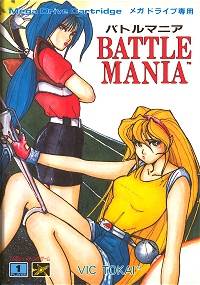Software:Trouble Shooter
| Trouble Shooter | |
|---|---|
 Japanese cover art | |
| Developer(s) | Vic Tokai |
| Publisher(s) | Vic Tokai |
| Director(s) | Takayan |
| Composer(s) | Hiroto Kanno |
| Platform(s) | Mega Drive/Genesis |
| Release | |
| Genre(s) | Scrolling shooter |
| Mode(s) | Single-player |
Trouble Shooter, originally released in Japan as Lua error in Module:Lang/utilities at line 332: attempt to call field '_transl' (a nil value)., is a horizontally scrolling shooter developed and published by Vic Tokai for the Mega Drive/Genesis. It was released in November 1991 in North America and March 6, 1992 in Japan. It was directed by game designer Takayan,who at first was primarily responsible for every aspect of the game's development due to a lack of support from Vic Tokai. Over time, however, more people joined the project, and he took on a supervisory role for much of the game's design.
The game was given a very distinct theme of self-parody between the enemies, story and dialogue. A sequel titled Battle Mania Daiginjō was also released for the Mega Drive in Japan and Korea only.
Gameplay
A combat operative Madison is assigned to rescue a prince who has been taken hostage. Players assume control over Lua error in Module:Lang/utilities at line 332: attempt to call field '_transl' (a nil value). who is accompanied at all times by her partner Lua error in Module:Lang/utilities at line 332: attempt to call field '_transl' (a nil value).. Unlike Madison, Crystal can flip firing positions, allowing her to fire behind Madison, and is invulnerable to all enemy fire.
At the beginning of almost every stage, the players have to choose a special weapon they can use during combat. After every use, however, the weapon needs to recharge in order to be used again. Players can select from four different power-ups consisting of the usual shooter icons (speed-ups, life-ups, firepower and speed-downs). The player can stock up on Madison's hit points by collecting life-up icons, which is necessary as the game has no lives system and only offers the player three continues.
Development
Trouble Shooter was designed by Takayan, who fought hard in order to be able to get the game greenlit. Its basis was a prototype arcade game made years prior, and Takayan worked on every element of the game by himself early on due to Vic Tokai's reluctance about the project. The concept for Battle Mania was based on an idea for a manga that was set between 1995 and 1997, though it was originally meant to cover a longer span of time. Over time, more people joined the project. Takayan was in charge of multiple areas, including public relations, game design, sales, graphics, programming, music, and scheduling. However, most of the work was done by other members of development, with Takayan acting as support.[1]
A scene where the protagonist is stomping on a Super Famicom was added due to Takayan being annoyed by the budget given to Super Famicom games compared to Genesis games. Following this, a fax was sent to Sega development studios to avoid things that may disparage other companies' characters and trademarks. Takayan speculated that he got away with it because Sega did not like Nintendo much at the time.[1] This was removed from the English release.[2] Crystal's appearance where she explain the weapons in the game was originally going to be a man named Fugu, accompanied by a one-eyed cat with wheels for hind legs and pincers for front legs. Fugu was based on a character of the same name in the manga Trouble is My Business. Fugu was very unpopular with Sega's quality assurance team, leading to him being cut, which Takayan regrets. Other things that served as an inspiration include the book series "The Gaming Magi" 80s idol Noriko Sakai, and locations near Sega's headquarters.[1]
Release
Despite finishing development in 1990, the game was not released until November 1991 in North America. It was later released in Japan on March 6, 1992.
Initially, management was not interested in producing a sequel despite Takayan's interest; however, market research showed that Trouble Shooter was popular, and thus he was allowed to make its sequel, Battle Mania. Having thrown away his design document for Trouble Shooter, he had to try to remember what he could for the sequel.[1] While Trouble Shooter released in the United States, its sequel would only release in Japan and Korea.
Reception
| Reception | ||||||
|---|---|---|---|---|---|---|
| ||||||
Trouble Shooter was mostly highly positively received by critics. GamePro writer Doctor Dave gave it a perfect score in every category, praising the "dynamic" gameplay and the ending as being worth experiencing.[3] Les Ellis from Sega Pro gave it a more reserved review score of 73%, calling it "a rehash of Forgotten Worlds without all the great power-ups."[4]
Sega-16 writer Ken Horowitz felt that it would be well-loved by horizontal shooter fans. bemoaning the game's box art and speculating that it contributed to people avoiding the game in the US. Despite some misgivings with the difficulty, Horowitz still enjoyed the game.[5]
Notes
References
- ↑ 1.0 1.1 1.2 1.3 Ichizo, Sorge (2004). "Battle Mania". 謎のゲーム魔境 巻次:4(ロストゲームズDECO &ビッグ東海編) (Micro Magazine). ISBN 4-89637-174-7.
- ↑ "Battle Mania – 2004 Developer Interview". Lost Games. 2004. https://shmuplations.com/battlemania/. Retrieved May 11, 2023.
- ↑ 3.0 3.1 GamePro 30 (January 1992), page 66.
- ↑ "Out-of-Print Archive • Mega Drive reviews • Trouble Shooter". Outofprintarchive.com. http://www.outofprintarchive.com/articles/reviews/MegaDrive/TroubleShooter-SegaPro8-1.html. Retrieved 2015-11-12.
- ↑ "Sega-16 – Trouble Shooter". Sega-16.com. 2008-07-24. http://www.sega-16.com/2008/07/trouble-shooter/. Retrieved 2015-11-12.
External links
 |

